Facilitating Change: Strategies in Health and Social Care Sector
VerifiedAdded on 2024/06/07
|19
|4101
|184
Essay
AI Summary
This essay provides a comprehensive analysis of facilitating change within the health and social care sector. It begins by defining change and its importance, followed by an examination of various factors driving change, including political, legal, economic, technological, demographic, and socio-cultural influences, utilizing PEST analysis. The challenges associated with these change factors are assessed through SWOT analysis, highlighting strengths, weaknesses, opportunities, and threats. The essay further delves into strategies for measuring the impact of recent changes, emphasizing the importance of stakeholder feedback, quality measurement, and surveys. It evaluates the overall impact of these changes on service quality, customer satisfaction, and staff satisfaction, proposing appropriate service responses to recent changes to enhance the effectiveness of healthcare organizations and improve patient care. Desklib offers a wealth of resources, including solved assignments and past papers, to support students in understanding complex topics like change management in healthcare.
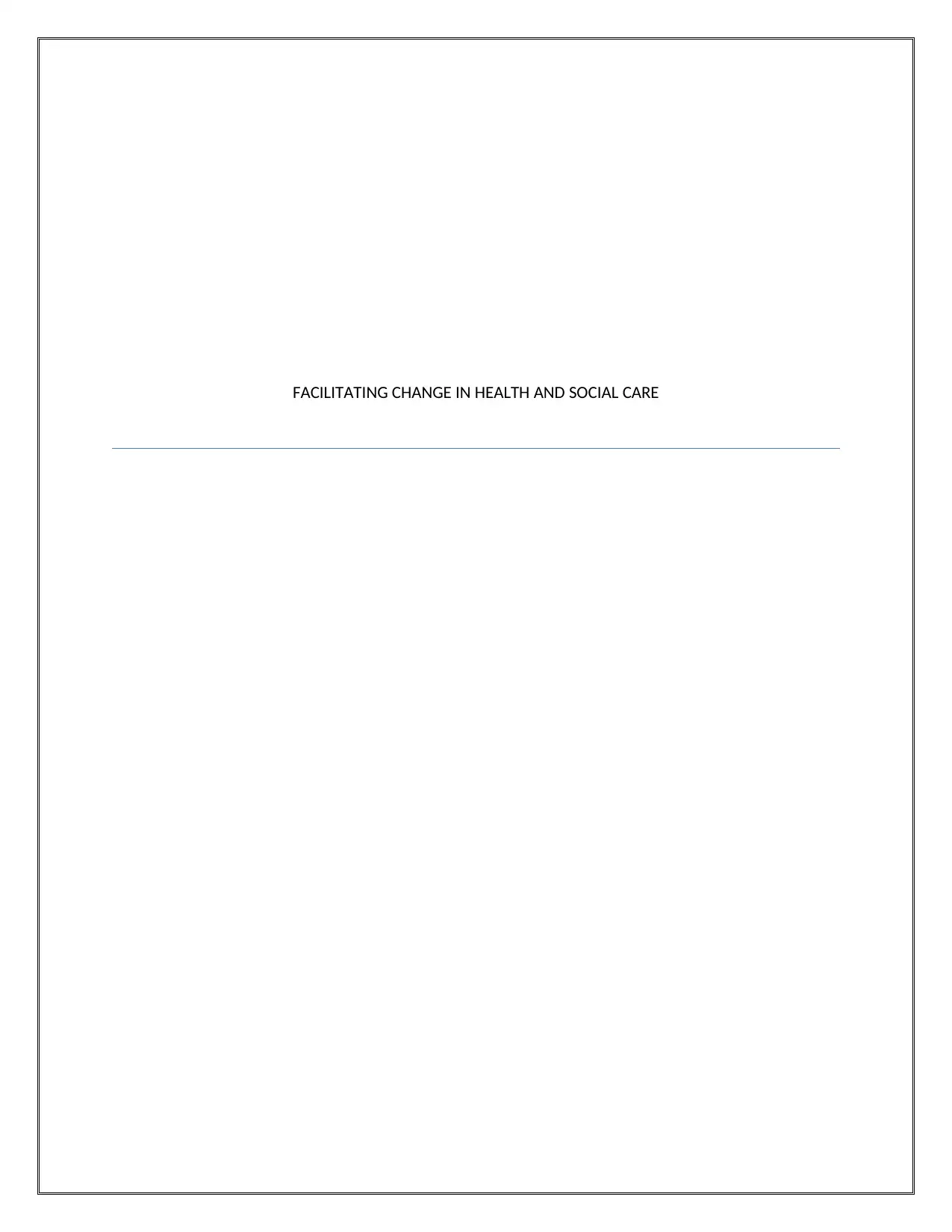
FACILITATING CHANGE IN HEALTH AND SOCIAL CARE
Paraphrase This Document
Need a fresh take? Get an instant paraphrase of this document with our AI Paraphraser
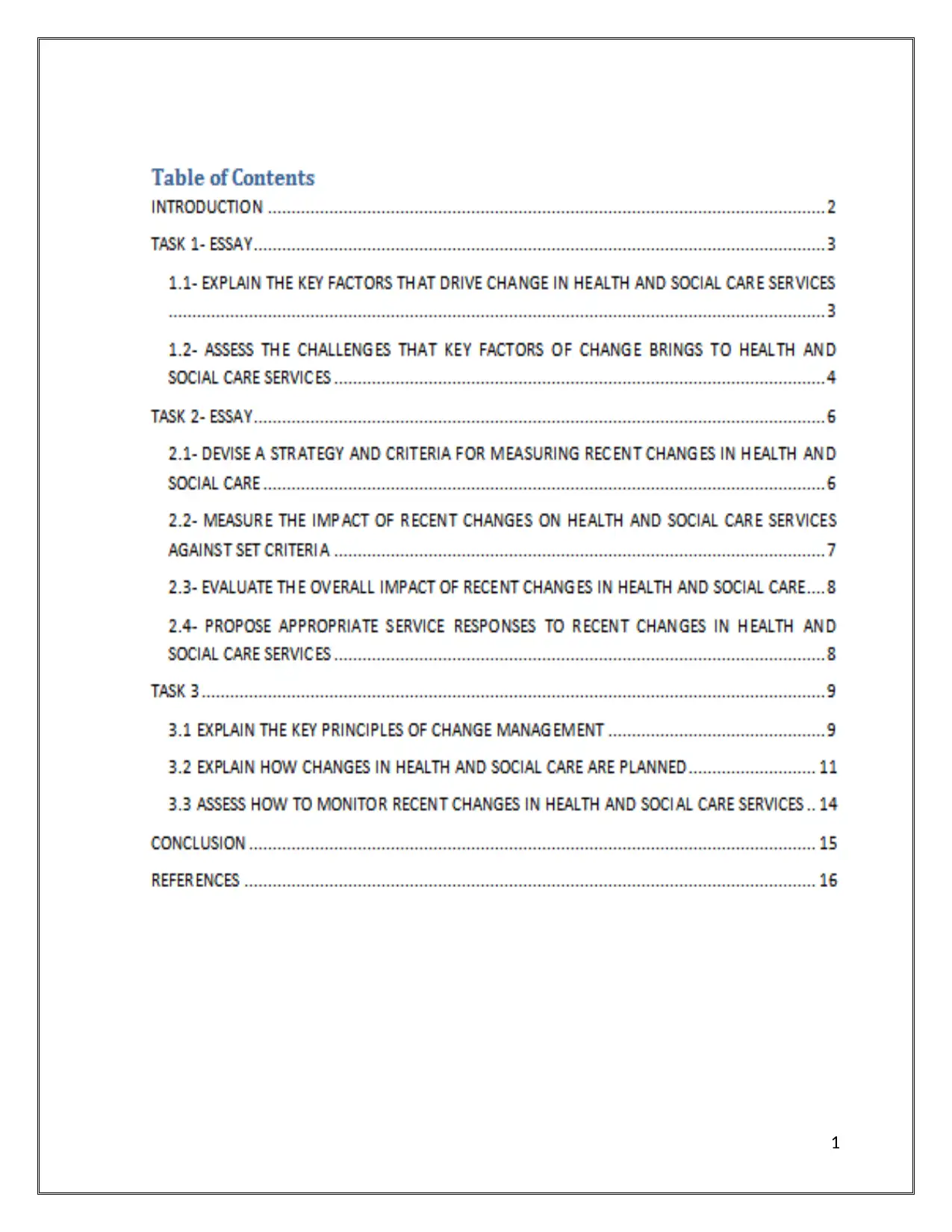
1
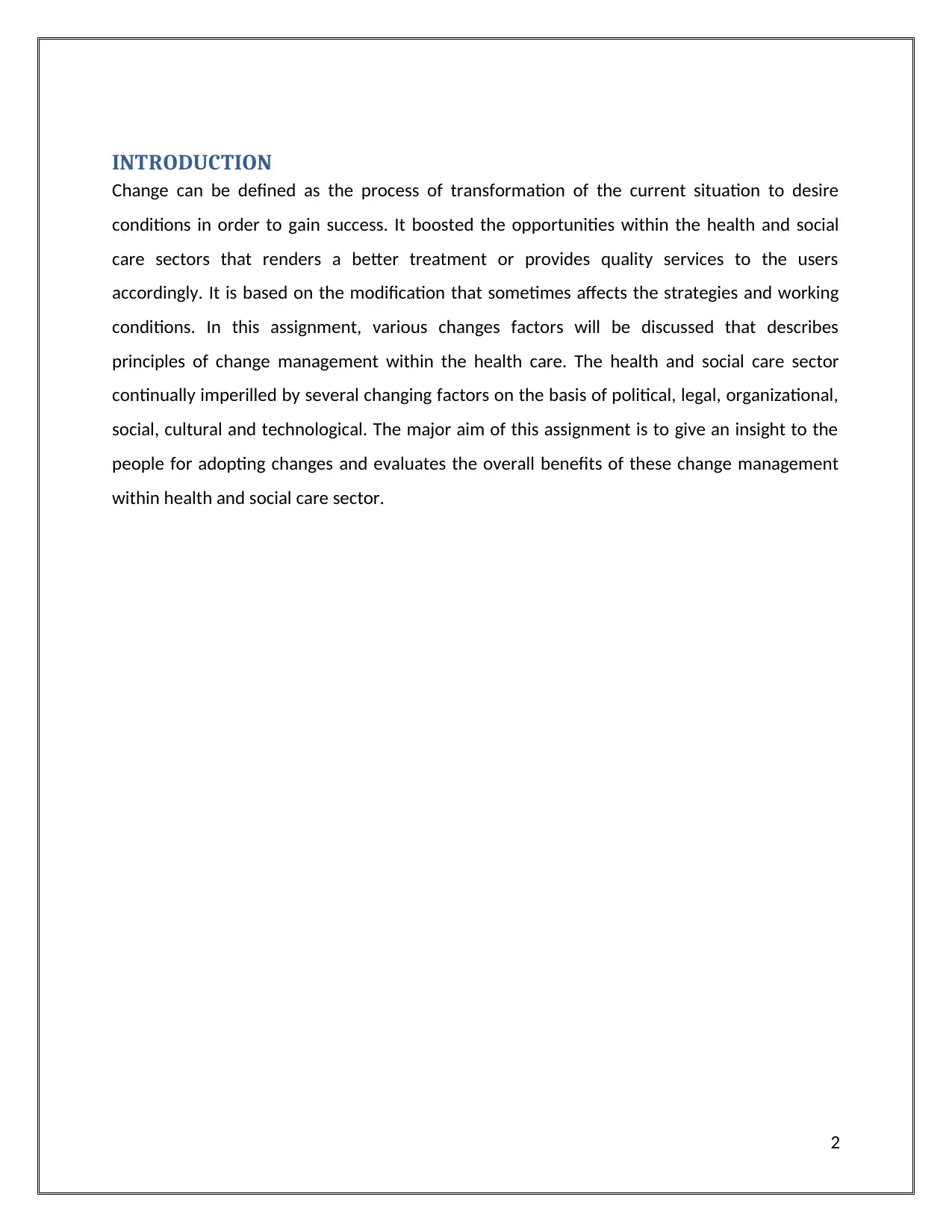
INTRODUCTION
Change can be defined as the process of transformation of the current situation to desire
conditions in order to gain success. It boosted the opportunities within the health and social
care sectors that renders a better treatment or provides quality services to the users
accordingly. It is based on the modification that sometimes affects the strategies and working
conditions. In this assignment, various changes factors will be discussed that describes
principles of change management within the health care. The health and social care sector
continually imperilled by several changing factors on the basis of political, legal, organizational,
social, cultural and technological. The major aim of this assignment is to give an insight to the
people for adopting changes and evaluates the overall benefits of these change management
within health and social care sector.
2
Change can be defined as the process of transformation of the current situation to desire
conditions in order to gain success. It boosted the opportunities within the health and social
care sectors that renders a better treatment or provides quality services to the users
accordingly. It is based on the modification that sometimes affects the strategies and working
conditions. In this assignment, various changes factors will be discussed that describes
principles of change management within the health care. The health and social care sector
continually imperilled by several changing factors on the basis of political, legal, organizational,
social, cultural and technological. The major aim of this assignment is to give an insight to the
people for adopting changes and evaluates the overall benefits of these change management
within health and social care sector.
2
⊘ This is a preview!⊘
Do you want full access?
Subscribe today to unlock all pages.

Trusted by 1+ million students worldwide
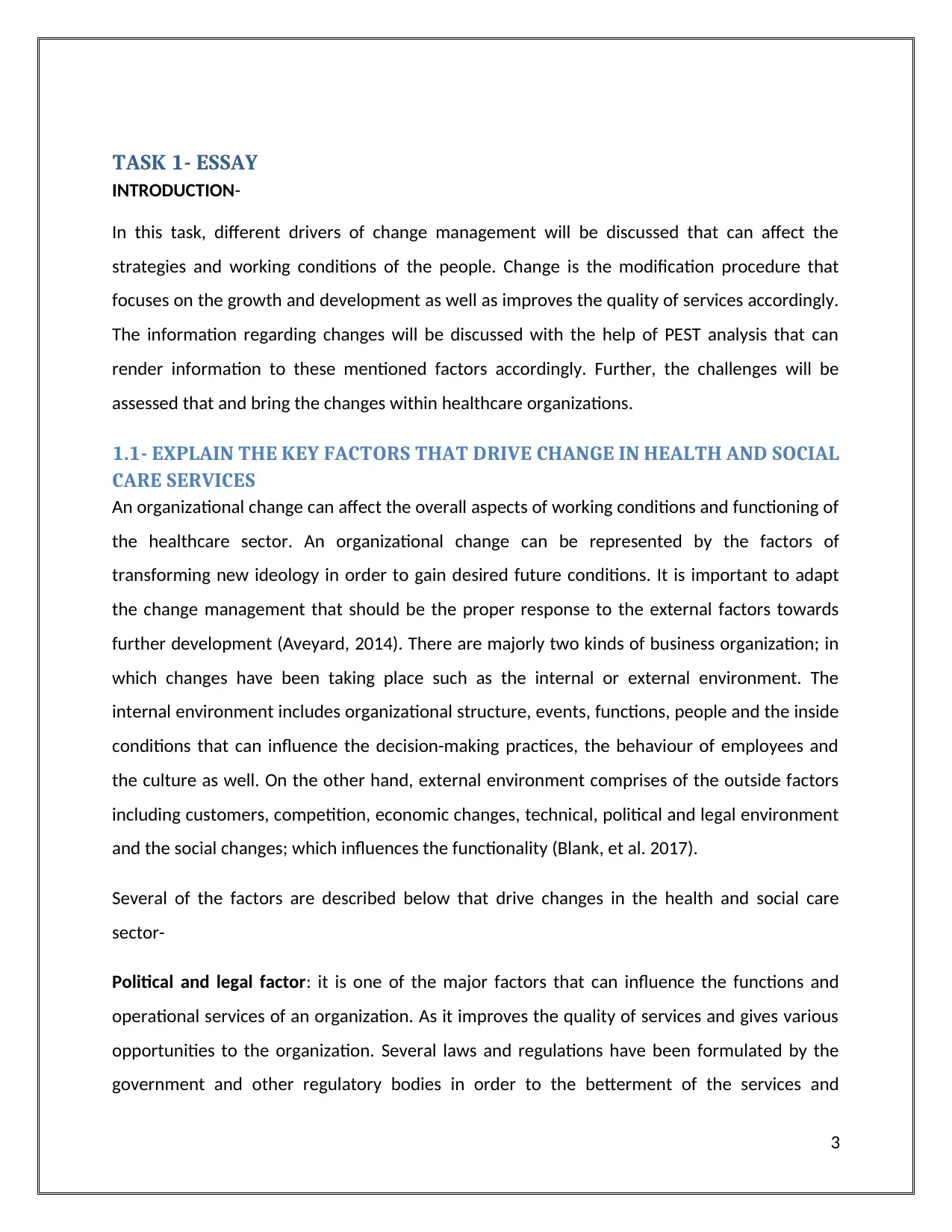
TASK 1- ESSAY
INTRODUCTION-
In this task, different drivers of change management will be discussed that can affect the
strategies and working conditions of the people. Change is the modification procedure that
focuses on the growth and development as well as improves the quality of services accordingly.
The information regarding changes will be discussed with the help of PEST analysis that can
render information to these mentioned factors accordingly. Further, the challenges will be
assessed that and bring the changes within healthcare organizations.
1.1- EXPLAIN THE KEY FACTORS THAT DRIVE CHANGE IN HEALTH AND SOCIAL
CARE SERVICES
An organizational change can affect the overall aspects of working conditions and functioning of
the healthcare sector. An organizational change can be represented by the factors of
transforming new ideology in order to gain desired future conditions. It is important to adapt
the change management that should be the proper response to the external factors towards
further development (Aveyard, 2014). There are majorly two kinds of business organization; in
which changes have been taking place such as the internal or external environment. The
internal environment includes organizational structure, events, functions, people and the inside
conditions that can influence the decision-making practices, the behaviour of employees and
the culture as well. On the other hand, external environment comprises of the outside factors
including customers, competition, economic changes, technical, political and legal environment
and the social changes; which influences the functionality (Blank, et al. 2017).
Several of the factors are described below that drive changes in the health and social care
sector-
Political and legal factor: it is one of the major factors that can influence the functions and
operational services of an organization. As it improves the quality of services and gives various
opportunities to the organization. Several laws and regulations have been formulated by the
government and other regulatory bodies in order to the betterment of the services and
3
INTRODUCTION-
In this task, different drivers of change management will be discussed that can affect the
strategies and working conditions of the people. Change is the modification procedure that
focuses on the growth and development as well as improves the quality of services accordingly.
The information regarding changes will be discussed with the help of PEST analysis that can
render information to these mentioned factors accordingly. Further, the challenges will be
assessed that and bring the changes within healthcare organizations.
1.1- EXPLAIN THE KEY FACTORS THAT DRIVE CHANGE IN HEALTH AND SOCIAL
CARE SERVICES
An organizational change can affect the overall aspects of working conditions and functioning of
the healthcare sector. An organizational change can be represented by the factors of
transforming new ideology in order to gain desired future conditions. It is important to adapt
the change management that should be the proper response to the external factors towards
further development (Aveyard, 2014). There are majorly two kinds of business organization; in
which changes have been taking place such as the internal or external environment. The
internal environment includes organizational structure, events, functions, people and the inside
conditions that can influence the decision-making practices, the behaviour of employees and
the culture as well. On the other hand, external environment comprises of the outside factors
including customers, competition, economic changes, technical, political and legal environment
and the social changes; which influences the functionality (Blank, et al. 2017).
Several of the factors are described below that drive changes in the health and social care
sector-
Political and legal factor: it is one of the major factors that can influence the functions and
operational services of an organization. As it improves the quality of services and gives various
opportunities to the organization. Several laws and regulations have been formulated by the
government and other regulatory bodies in order to the betterment of the services and
3
Paraphrase This Document
Need a fresh take? Get an instant paraphrase of this document with our AI Paraphraser
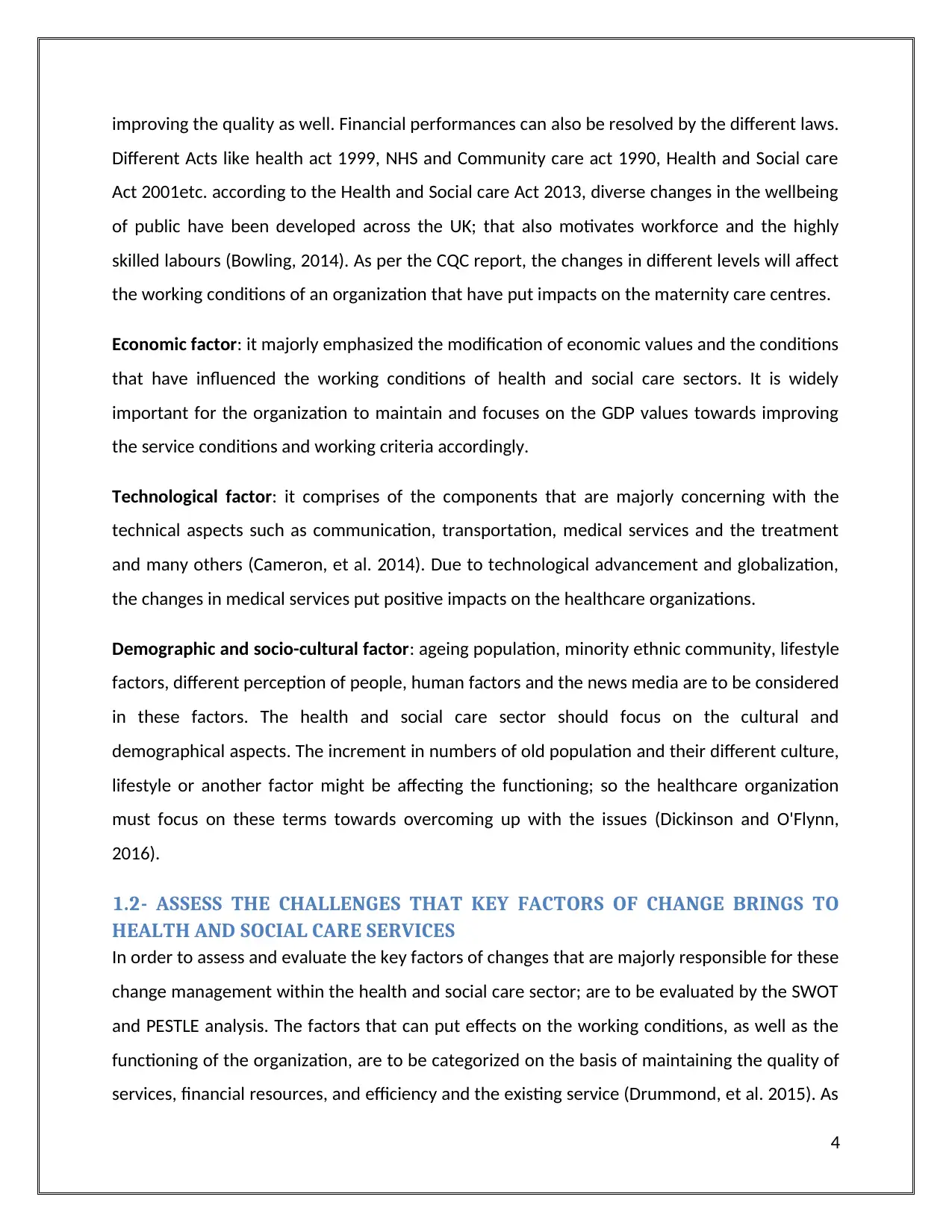
improving the quality as well. Financial performances can also be resolved by the different laws.
Different Acts like health act 1999, NHS and Community care act 1990, Health and Social care
Act 2001etc. according to the Health and Social care Act 2013, diverse changes in the wellbeing
of public have been developed across the UK; that also motivates workforce and the highly
skilled labours (Bowling, 2014). As per the CQC report, the changes in different levels will affect
the working conditions of an organization that have put impacts on the maternity care centres.
Economic factor: it majorly emphasized the modification of economic values and the conditions
that have influenced the working conditions of health and social care sectors. It is widely
important for the organization to maintain and focuses on the GDP values towards improving
the service conditions and working criteria accordingly.
Technological factor: it comprises of the components that are majorly concerning with the
technical aspects such as communication, transportation, medical services and the treatment
and many others (Cameron, et al. 2014). Due to technological advancement and globalization,
the changes in medical services put positive impacts on the healthcare organizations.
Demographic and socio-cultural factor: ageing population, minority ethnic community, lifestyle
factors, different perception of people, human factors and the news media are to be considered
in these factors. The health and social care sector should focus on the cultural and
demographical aspects. The increment in numbers of old population and their different culture,
lifestyle or another factor might be affecting the functioning; so the healthcare organization
must focus on these terms towards overcoming up with the issues (Dickinson and O'Flynn,
2016).
1.2- ASSESS THE CHALLENGES THAT KEY FACTORS OF CHANGE BRINGS TO
HEALTH AND SOCIAL CARE SERVICES
In order to assess and evaluate the key factors of changes that are majorly responsible for these
change management within the health and social care sector; are to be evaluated by the SWOT
and PESTLE analysis. The factors that can put effects on the working conditions, as well as the
functioning of the organization, are to be categorized on the basis of maintaining the quality of
services, financial resources, and efficiency and the existing service (Drummond, et al. 2015). As
4
Different Acts like health act 1999, NHS and Community care act 1990, Health and Social care
Act 2001etc. according to the Health and Social care Act 2013, diverse changes in the wellbeing
of public have been developed across the UK; that also motivates workforce and the highly
skilled labours (Bowling, 2014). As per the CQC report, the changes in different levels will affect
the working conditions of an organization that have put impacts on the maternity care centres.
Economic factor: it majorly emphasized the modification of economic values and the conditions
that have influenced the working conditions of health and social care sectors. It is widely
important for the organization to maintain and focuses on the GDP values towards improving
the service conditions and working criteria accordingly.
Technological factor: it comprises of the components that are majorly concerning with the
technical aspects such as communication, transportation, medical services and the treatment
and many others (Cameron, et al. 2014). Due to technological advancement and globalization,
the changes in medical services put positive impacts on the healthcare organizations.
Demographic and socio-cultural factor: ageing population, minority ethnic community, lifestyle
factors, different perception of people, human factors and the news media are to be considered
in these factors. The health and social care sector should focus on the cultural and
demographical aspects. The increment in numbers of old population and their different culture,
lifestyle or another factor might be affecting the functioning; so the healthcare organization
must focus on these terms towards overcoming up with the issues (Dickinson and O'Flynn,
2016).
1.2- ASSESS THE CHALLENGES THAT KEY FACTORS OF CHANGE BRINGS TO
HEALTH AND SOCIAL CARE SERVICES
In order to assess and evaluate the key factors of changes that are majorly responsible for these
change management within the health and social care sector; are to be evaluated by the SWOT
and PESTLE analysis. The factors that can put effects on the working conditions, as well as the
functioning of the organization, are to be categorized on the basis of maintaining the quality of
services, financial resources, and efficiency and the existing service (Drummond, et al. 2015). As
4
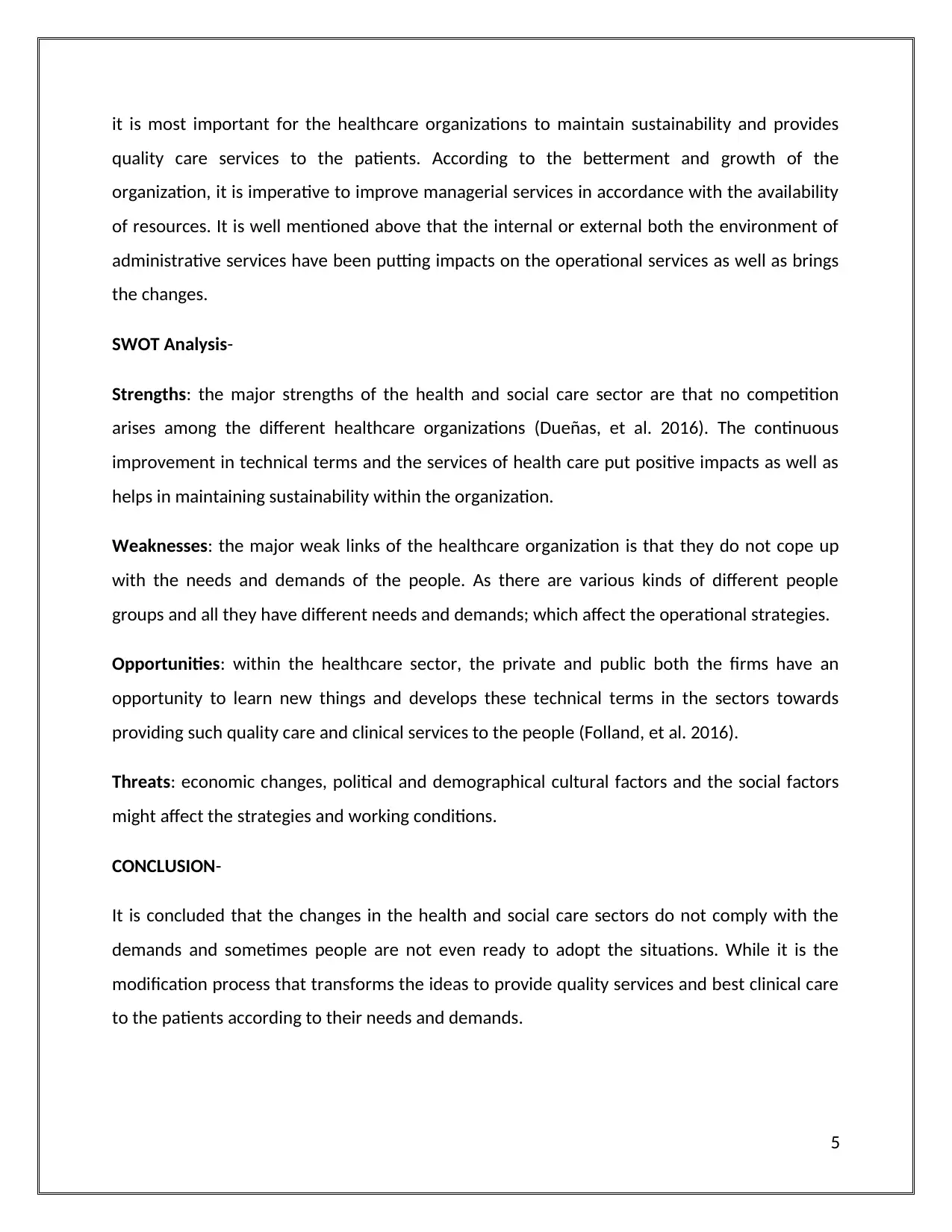
it is most important for the healthcare organizations to maintain sustainability and provides
quality care services to the patients. According to the betterment and growth of the
organization, it is imperative to improve managerial services in accordance with the availability
of resources. It is well mentioned above that the internal or external both the environment of
administrative services have been putting impacts on the operational services as well as brings
the changes.
SWOT Analysis-
Strengths: the major strengths of the health and social care sector are that no competition
arises among the different healthcare organizations (Dueñas, et al. 2016). The continuous
improvement in technical terms and the services of health care put positive impacts as well as
helps in maintaining sustainability within the organization.
Weaknesses: the major weak links of the healthcare organization is that they do not cope up
with the needs and demands of the people. As there are various kinds of different people
groups and all they have different needs and demands; which affect the operational strategies.
Opportunities: within the healthcare sector, the private and public both the firms have an
opportunity to learn new things and develops these technical terms in the sectors towards
providing such quality care and clinical services to the people (Folland, et al. 2016).
Threats: economic changes, political and demographical cultural factors and the social factors
might affect the strategies and working conditions.
CONCLUSION-
It is concluded that the changes in the health and social care sectors do not comply with the
demands and sometimes people are not even ready to adopt the situations. While it is the
modification process that transforms the ideas to provide quality services and best clinical care
to the patients according to their needs and demands.
5
quality care services to the patients. According to the betterment and growth of the
organization, it is imperative to improve managerial services in accordance with the availability
of resources. It is well mentioned above that the internal or external both the environment of
administrative services have been putting impacts on the operational services as well as brings
the changes.
SWOT Analysis-
Strengths: the major strengths of the health and social care sector are that no competition
arises among the different healthcare organizations (Dueñas, et al. 2016). The continuous
improvement in technical terms and the services of health care put positive impacts as well as
helps in maintaining sustainability within the organization.
Weaknesses: the major weak links of the healthcare organization is that they do not cope up
with the needs and demands of the people. As there are various kinds of different people
groups and all they have different needs and demands; which affect the operational strategies.
Opportunities: within the healthcare sector, the private and public both the firms have an
opportunity to learn new things and develops these technical terms in the sectors towards
providing such quality care and clinical services to the people (Folland, et al. 2016).
Threats: economic changes, political and demographical cultural factors and the social factors
might affect the strategies and working conditions.
CONCLUSION-
It is concluded that the changes in the health and social care sectors do not comply with the
demands and sometimes people are not even ready to adopt the situations. While it is the
modification process that transforms the ideas to provide quality services and best clinical care
to the patients according to their needs and demands.
5
⊘ This is a preview!⊘
Do you want full access?
Subscribe today to unlock all pages.

Trusted by 1+ million students worldwide
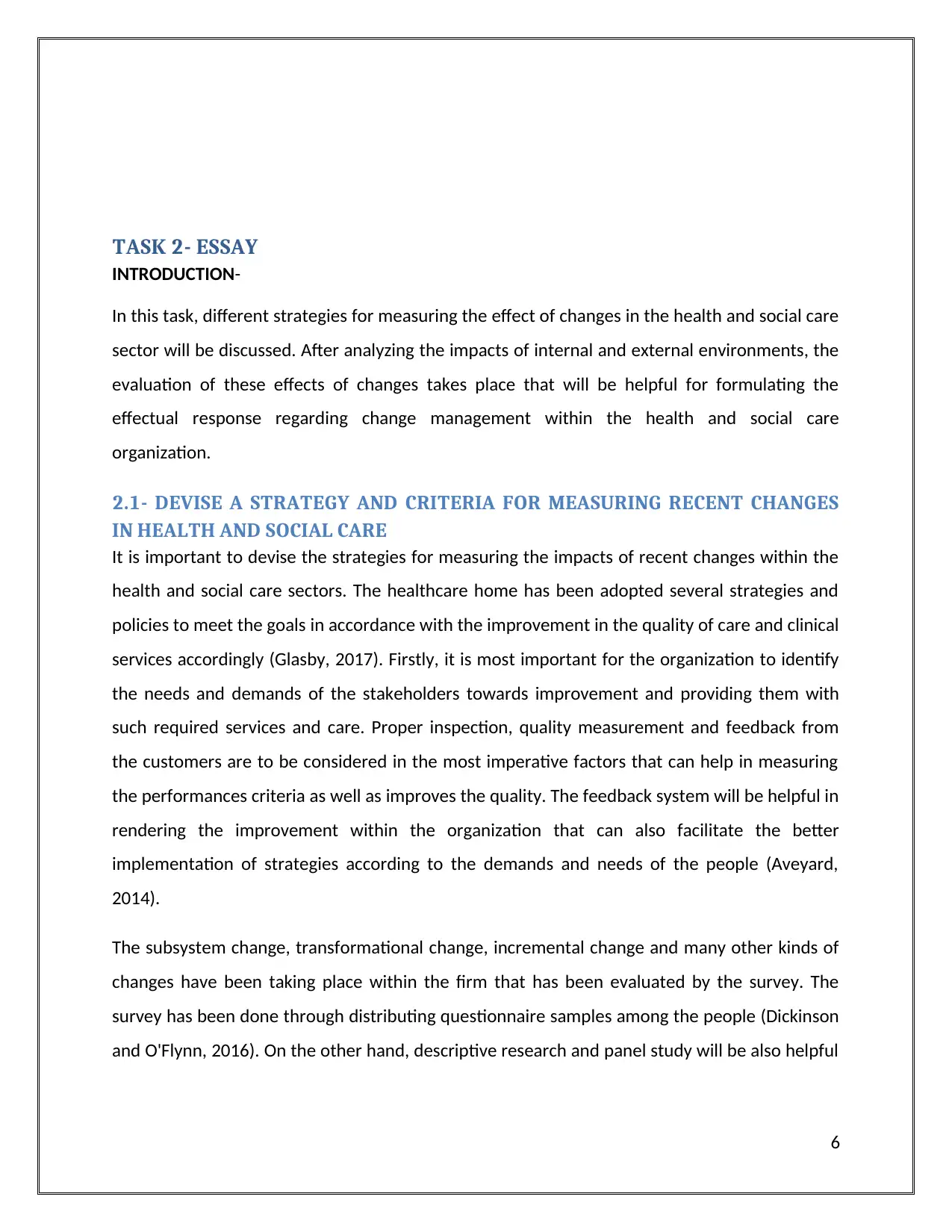
TASK 2- ESSAY
INTRODUCTION-
In this task, different strategies for measuring the effect of changes in the health and social care
sector will be discussed. After analyzing the impacts of internal and external environments, the
evaluation of these effects of changes takes place that will be helpful for formulating the
effectual response regarding change management within the health and social care
organization.
2.1- DEVISE A STRATEGY AND CRITERIA FOR MEASURING RECENT CHANGES
IN HEALTH AND SOCIAL CARE
It is important to devise the strategies for measuring the impacts of recent changes within the
health and social care sectors. The healthcare home has been adopted several strategies and
policies to meet the goals in accordance with the improvement in the quality of care and clinical
services accordingly (Glasby, 2017). Firstly, it is most important for the organization to identify
the needs and demands of the stakeholders towards improvement and providing them with
such required services and care. Proper inspection, quality measurement and feedback from
the customers are to be considered in the most imperative factors that can help in measuring
the performances criteria as well as improves the quality. The feedback system will be helpful in
rendering the improvement within the organization that can also facilitate the better
implementation of strategies according to the demands and needs of the people (Aveyard,
2014).
The subsystem change, transformational change, incremental change and many other kinds of
changes have been taking place within the firm that has been evaluated by the survey. The
survey has been done through distributing questionnaire samples among the people (Dickinson
and O'Flynn, 2016). On the other hand, descriptive research and panel study will be also helpful
6
INTRODUCTION-
In this task, different strategies for measuring the effect of changes in the health and social care
sector will be discussed. After analyzing the impacts of internal and external environments, the
evaluation of these effects of changes takes place that will be helpful for formulating the
effectual response regarding change management within the health and social care
organization.
2.1- DEVISE A STRATEGY AND CRITERIA FOR MEASURING RECENT CHANGES
IN HEALTH AND SOCIAL CARE
It is important to devise the strategies for measuring the impacts of recent changes within the
health and social care sectors. The healthcare home has been adopted several strategies and
policies to meet the goals in accordance with the improvement in the quality of care and clinical
services accordingly (Glasby, 2017). Firstly, it is most important for the organization to identify
the needs and demands of the stakeholders towards improvement and providing them with
such required services and care. Proper inspection, quality measurement and feedback from
the customers are to be considered in the most imperative factors that can help in measuring
the performances criteria as well as improves the quality. The feedback system will be helpful in
rendering the improvement within the organization that can also facilitate the better
implementation of strategies according to the demands and needs of the people (Aveyard,
2014).
The subsystem change, transformational change, incremental change and many other kinds of
changes have been taking place within the firm that has been evaluated by the survey. The
survey has been done through distributing questionnaire samples among the people (Dickinson
and O'Flynn, 2016). On the other hand, descriptive research and panel study will be also helpful
6
Paraphrase This Document
Need a fresh take? Get an instant paraphrase of this document with our AI Paraphraser
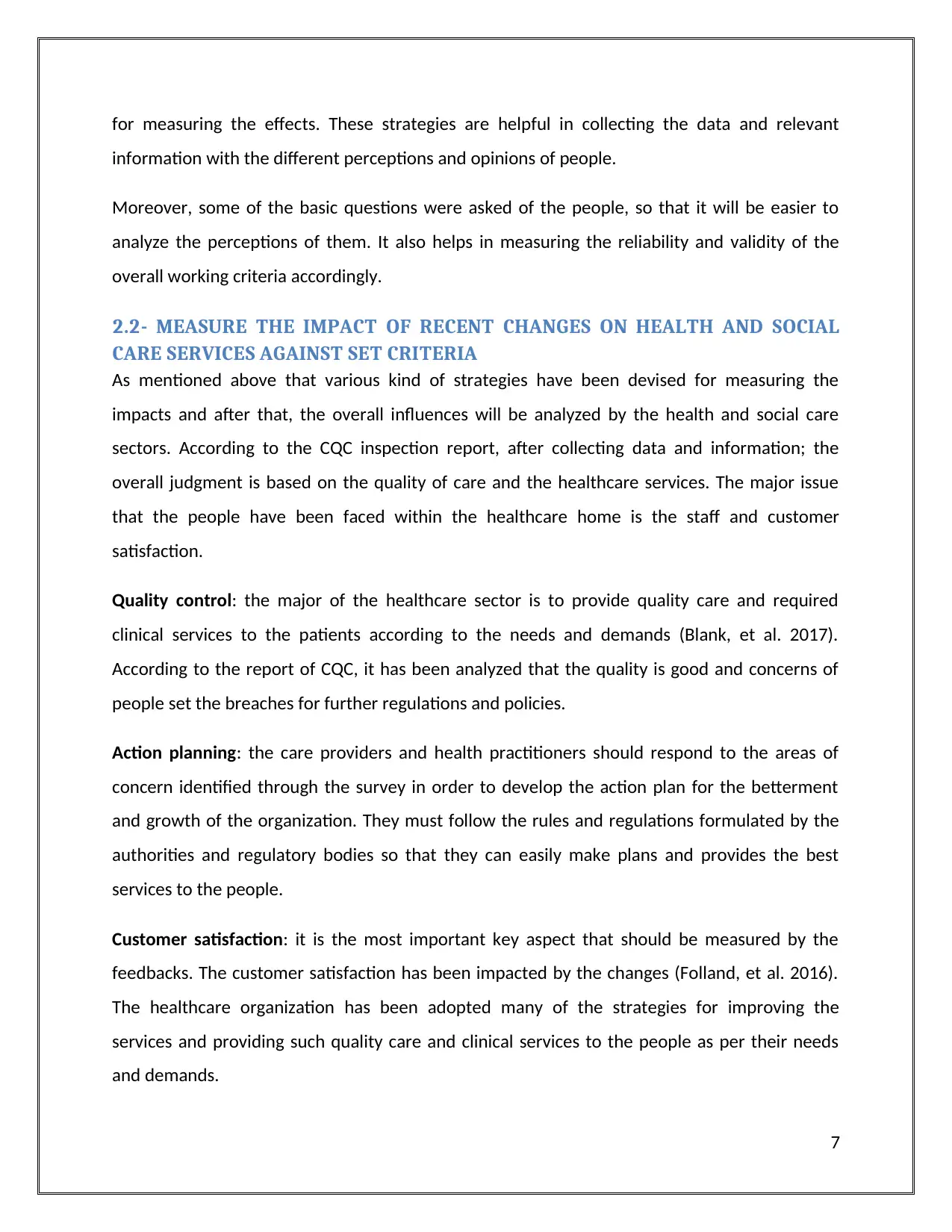
for measuring the effects. These strategies are helpful in collecting the data and relevant
information with the different perceptions and opinions of people.
Moreover, some of the basic questions were asked of the people, so that it will be easier to
analyze the perceptions of them. It also helps in measuring the reliability and validity of the
overall working criteria accordingly.
2.2- MEASURE THE IMPACT OF RECENT CHANGES ON HEALTH AND SOCIAL
CARE SERVICES AGAINST SET CRITERIA
As mentioned above that various kind of strategies have been devised for measuring the
impacts and after that, the overall influences will be analyzed by the health and social care
sectors. According to the CQC inspection report, after collecting data and information; the
overall judgment is based on the quality of care and the healthcare services. The major issue
that the people have been faced within the healthcare home is the staff and customer
satisfaction.
Quality control: the major of the healthcare sector is to provide quality care and required
clinical services to the patients according to the needs and demands (Blank, et al. 2017).
According to the report of CQC, it has been analyzed that the quality is good and concerns of
people set the breaches for further regulations and policies.
Action planning: the care providers and health practitioners should respond to the areas of
concern identified through the survey in order to develop the action plan for the betterment
and growth of the organization. They must follow the rules and regulations formulated by the
authorities and regulatory bodies so that they can easily make plans and provides the best
services to the people.
Customer satisfaction: it is the most important key aspect that should be measured by the
feedbacks. The customer satisfaction has been impacted by the changes (Folland, et al. 2016).
The healthcare organization has been adopted many of the strategies for improving the
services and providing such quality care and clinical services to the people as per their needs
and demands.
7
information with the different perceptions and opinions of people.
Moreover, some of the basic questions were asked of the people, so that it will be easier to
analyze the perceptions of them. It also helps in measuring the reliability and validity of the
overall working criteria accordingly.
2.2- MEASURE THE IMPACT OF RECENT CHANGES ON HEALTH AND SOCIAL
CARE SERVICES AGAINST SET CRITERIA
As mentioned above that various kind of strategies have been devised for measuring the
impacts and after that, the overall influences will be analyzed by the health and social care
sectors. According to the CQC inspection report, after collecting data and information; the
overall judgment is based on the quality of care and the healthcare services. The major issue
that the people have been faced within the healthcare home is the staff and customer
satisfaction.
Quality control: the major of the healthcare sector is to provide quality care and required
clinical services to the patients according to the needs and demands (Blank, et al. 2017).
According to the report of CQC, it has been analyzed that the quality is good and concerns of
people set the breaches for further regulations and policies.
Action planning: the care providers and health practitioners should respond to the areas of
concern identified through the survey in order to develop the action plan for the betterment
and growth of the organization. They must follow the rules and regulations formulated by the
authorities and regulatory bodies so that they can easily make plans and provides the best
services to the people.
Customer satisfaction: it is the most important key aspect that should be measured by the
feedbacks. The customer satisfaction has been impacted by the changes (Folland, et al. 2016).
The healthcare organization has been adopted many of the strategies for improving the
services and providing such quality care and clinical services to the people as per their needs
and demands.
7
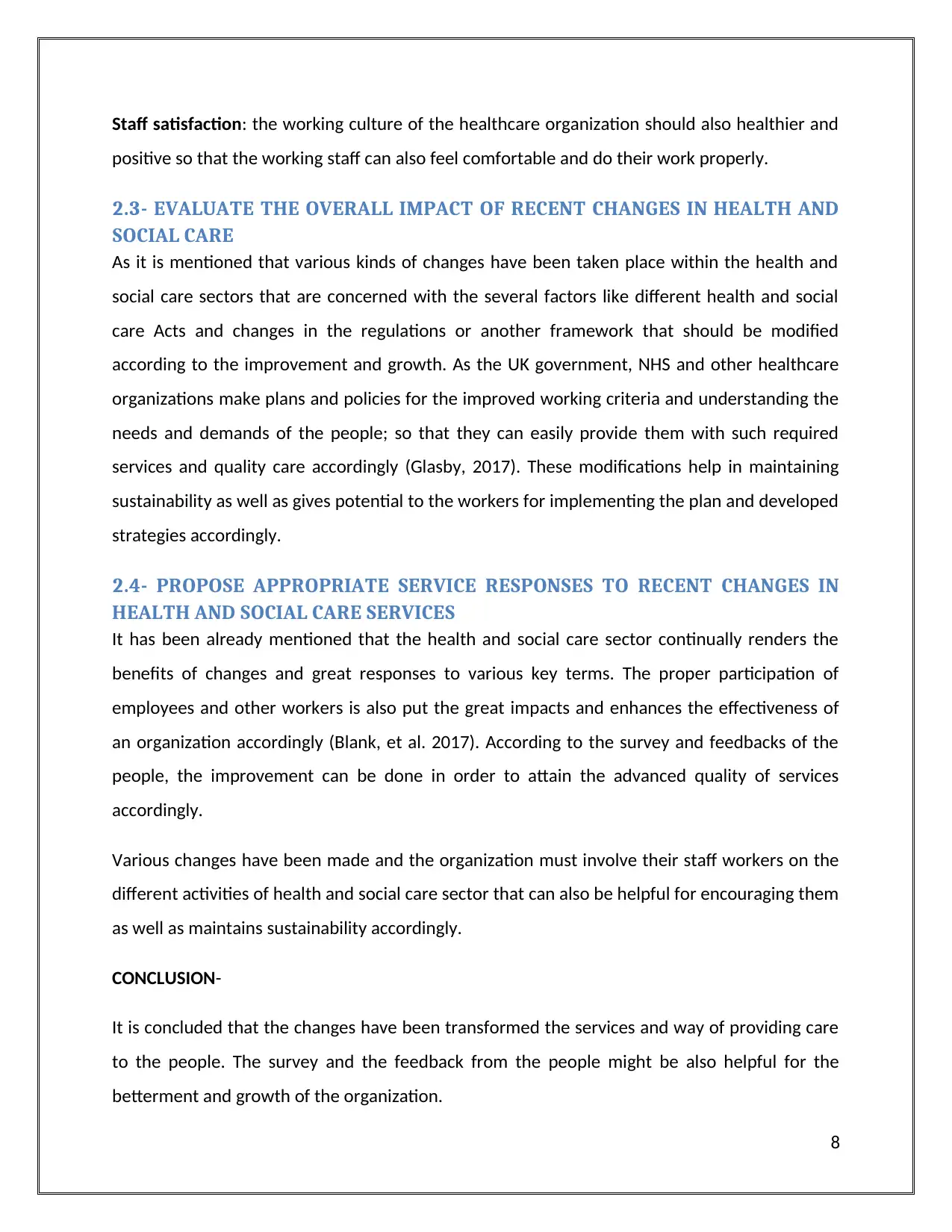
Staff satisfaction: the working culture of the healthcare organization should also healthier and
positive so that the working staff can also feel comfortable and do their work properly.
2.3- EVALUATE THE OVERALL IMPACT OF RECENT CHANGES IN HEALTH AND
SOCIAL CARE
As it is mentioned that various kinds of changes have been taken place within the health and
social care sectors that are concerned with the several factors like different health and social
care Acts and changes in the regulations or another framework that should be modified
according to the improvement and growth. As the UK government, NHS and other healthcare
organizations make plans and policies for the improved working criteria and understanding the
needs and demands of the people; so that they can easily provide them with such required
services and quality care accordingly (Glasby, 2017). These modifications help in maintaining
sustainability as well as gives potential to the workers for implementing the plan and developed
strategies accordingly.
2.4- PROPOSE APPROPRIATE SERVICE RESPONSES TO RECENT CHANGES IN
HEALTH AND SOCIAL CARE SERVICES
It has been already mentioned that the health and social care sector continually renders the
benefits of changes and great responses to various key terms. The proper participation of
employees and other workers is also put the great impacts and enhances the effectiveness of
an organization accordingly (Blank, et al. 2017). According to the survey and feedbacks of the
people, the improvement can be done in order to attain the advanced quality of services
accordingly.
Various changes have been made and the organization must involve their staff workers on the
different activities of health and social care sector that can also be helpful for encouraging them
as well as maintains sustainability accordingly.
CONCLUSION-
It is concluded that the changes have been transformed the services and way of providing care
to the people. The survey and the feedback from the people might be also helpful for the
betterment and growth of the organization.
8
positive so that the working staff can also feel comfortable and do their work properly.
2.3- EVALUATE THE OVERALL IMPACT OF RECENT CHANGES IN HEALTH AND
SOCIAL CARE
As it is mentioned that various kinds of changes have been taken place within the health and
social care sectors that are concerned with the several factors like different health and social
care Acts and changes in the regulations or another framework that should be modified
according to the improvement and growth. As the UK government, NHS and other healthcare
organizations make plans and policies for the improved working criteria and understanding the
needs and demands of the people; so that they can easily provide them with such required
services and quality care accordingly (Glasby, 2017). These modifications help in maintaining
sustainability as well as gives potential to the workers for implementing the plan and developed
strategies accordingly.
2.4- PROPOSE APPROPRIATE SERVICE RESPONSES TO RECENT CHANGES IN
HEALTH AND SOCIAL CARE SERVICES
It has been already mentioned that the health and social care sector continually renders the
benefits of changes and great responses to various key terms. The proper participation of
employees and other workers is also put the great impacts and enhances the effectiveness of
an organization accordingly (Blank, et al. 2017). According to the survey and feedbacks of the
people, the improvement can be done in order to attain the advanced quality of services
accordingly.
Various changes have been made and the organization must involve their staff workers on the
different activities of health and social care sector that can also be helpful for encouraging them
as well as maintains sustainability accordingly.
CONCLUSION-
It is concluded that the changes have been transformed the services and way of providing care
to the people. The survey and the feedback from the people might be also helpful for the
betterment and growth of the organization.
8
⊘ This is a preview!⊘
Do you want full access?
Subscribe today to unlock all pages.

Trusted by 1+ million students worldwide

9
Paraphrase This Document
Need a fresh take? Get an instant paraphrase of this document with our AI Paraphraser
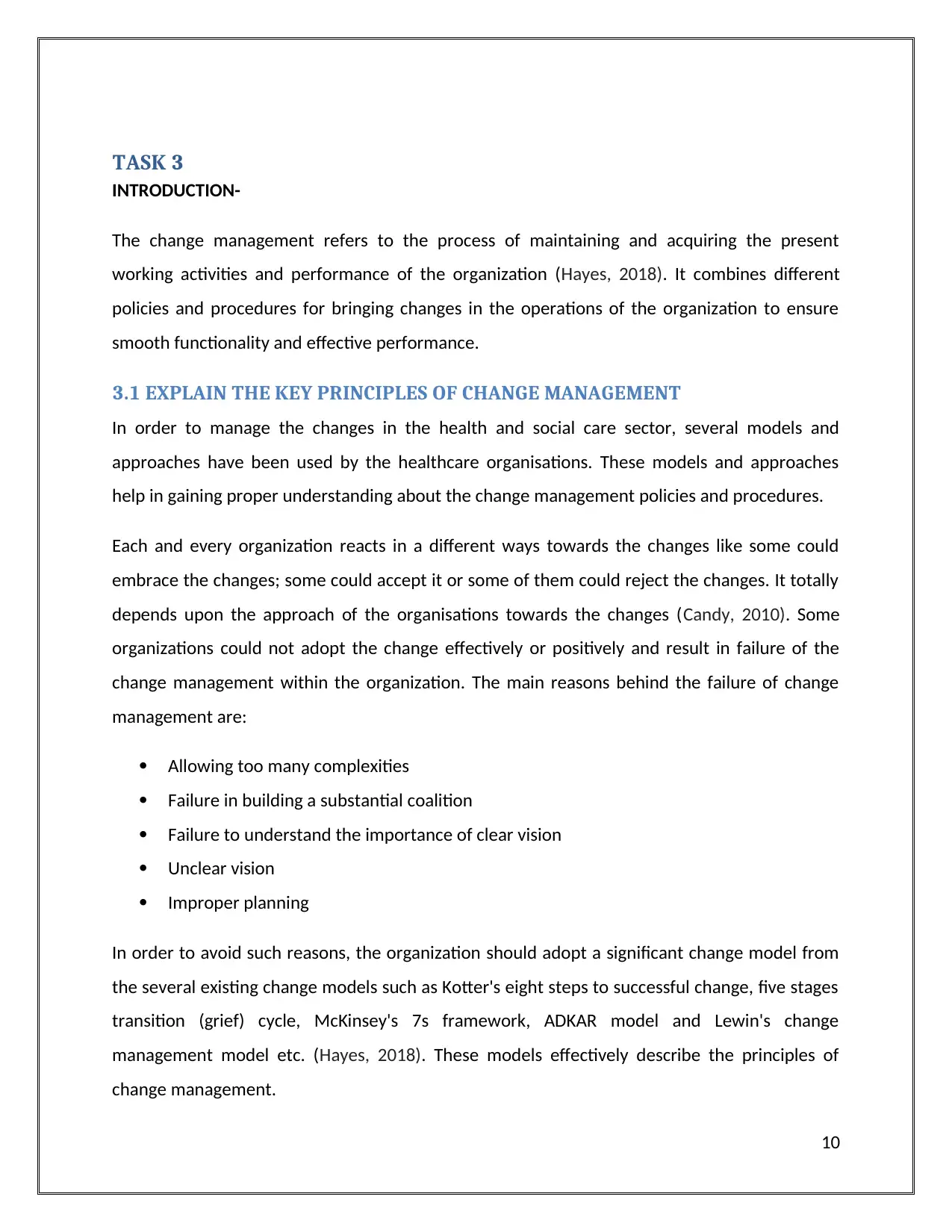
TASK 3
INTRODUCTION-
The change management refers to the process of maintaining and acquiring the present
working activities and performance of the organization (Hayes, 2018). It combines different
policies and procedures for bringing changes in the operations of the organization to ensure
smooth functionality and effective performance.
3.1 EXPLAIN THE KEY PRINCIPLES OF CHANGE MANAGEMENT
In order to manage the changes in the health and social care sector, several models and
approaches have been used by the healthcare organisations. These models and approaches
help in gaining proper understanding about the change management policies and procedures.
Each and every organization reacts in a different ways towards the changes like some could
embrace the changes; some could accept it or some of them could reject the changes. It totally
depends upon the approach of the organisations towards the changes (Candy, 2010). Some
organizations could not adopt the change effectively or positively and result in failure of the
change management within the organization. The main reasons behind the failure of change
management are:
Allowing too many complexities
Failure in building a substantial coalition
Failure to understand the importance of clear vision
Unclear vision
Improper planning
In order to avoid such reasons, the organization should adopt a significant change model from
the several existing change models such as Kotter's eight steps to successful change, five stages
transition (grief) cycle, McKinsey's 7s framework, ADKAR model and Lewin's change
management model etc. (Hayes, 2018). These models effectively describe the principles of
change management.
10
INTRODUCTION-
The change management refers to the process of maintaining and acquiring the present
working activities and performance of the organization (Hayes, 2018). It combines different
policies and procedures for bringing changes in the operations of the organization to ensure
smooth functionality and effective performance.
3.1 EXPLAIN THE KEY PRINCIPLES OF CHANGE MANAGEMENT
In order to manage the changes in the health and social care sector, several models and
approaches have been used by the healthcare organisations. These models and approaches
help in gaining proper understanding about the change management policies and procedures.
Each and every organization reacts in a different ways towards the changes like some could
embrace the changes; some could accept it or some of them could reject the changes. It totally
depends upon the approach of the organisations towards the changes (Candy, 2010). Some
organizations could not adopt the change effectively or positively and result in failure of the
change management within the organization. The main reasons behind the failure of change
management are:
Allowing too many complexities
Failure in building a substantial coalition
Failure to understand the importance of clear vision
Unclear vision
Improper planning
In order to avoid such reasons, the organization should adopt a significant change model from
the several existing change models such as Kotter's eight steps to successful change, five stages
transition (grief) cycle, McKinsey's 7s framework, ADKAR model and Lewin's change
management model etc. (Hayes, 2018). These models effectively describe the principles of
change management.
10
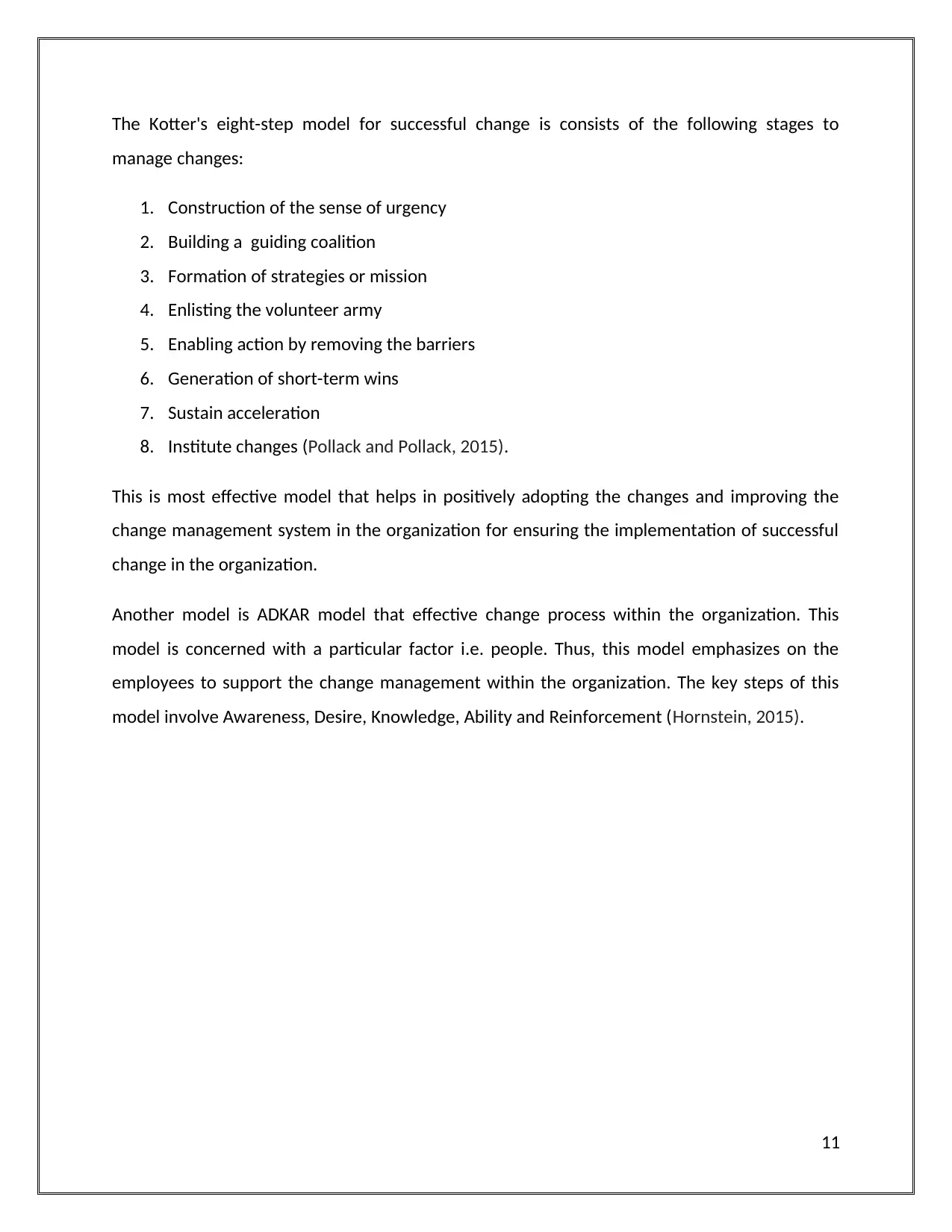
The Kotter's eight-step model for successful change is consists of the following stages to
manage changes:
1. Construction of the sense of urgency
2. Building a guiding coalition
3. Formation of strategies or mission
4. Enlisting the volunteer army
5. Enabling action by removing the barriers
6. Generation of short-term wins
7. Sustain acceleration
8. Institute changes (Pollack and Pollack, 2015).
This is most effective model that helps in positively adopting the changes and improving the
change management system in the organization for ensuring the implementation of successful
change in the organization.
Another model is ADKAR model that effective change process within the organization. This
model is concerned with a particular factor i.e. people. Thus, this model emphasizes on the
employees to support the change management within the organization. The key steps of this
model involve Awareness, Desire, Knowledge, Ability and Reinforcement (Hornstein, 2015).
11
manage changes:
1. Construction of the sense of urgency
2. Building a guiding coalition
3. Formation of strategies or mission
4. Enlisting the volunteer army
5. Enabling action by removing the barriers
6. Generation of short-term wins
7. Sustain acceleration
8. Institute changes (Pollack and Pollack, 2015).
This is most effective model that helps in positively adopting the changes and improving the
change management system in the organization for ensuring the implementation of successful
change in the organization.
Another model is ADKAR model that effective change process within the organization. This
model is concerned with a particular factor i.e. people. Thus, this model emphasizes on the
employees to support the change management within the organization. The key steps of this
model involve Awareness, Desire, Knowledge, Ability and Reinforcement (Hornstein, 2015).
11
⊘ This is a preview!⊘
Do you want full access?
Subscribe today to unlock all pages.

Trusted by 1+ million students worldwide
1 out of 19
Related Documents
Your All-in-One AI-Powered Toolkit for Academic Success.
+13062052269
info@desklib.com
Available 24*7 on WhatsApp / Email
![[object Object]](/_next/static/media/star-bottom.7253800d.svg)
Unlock your academic potential
Copyright © 2020–2025 A2Z Services. All Rights Reserved. Developed and managed by ZUCOL.




